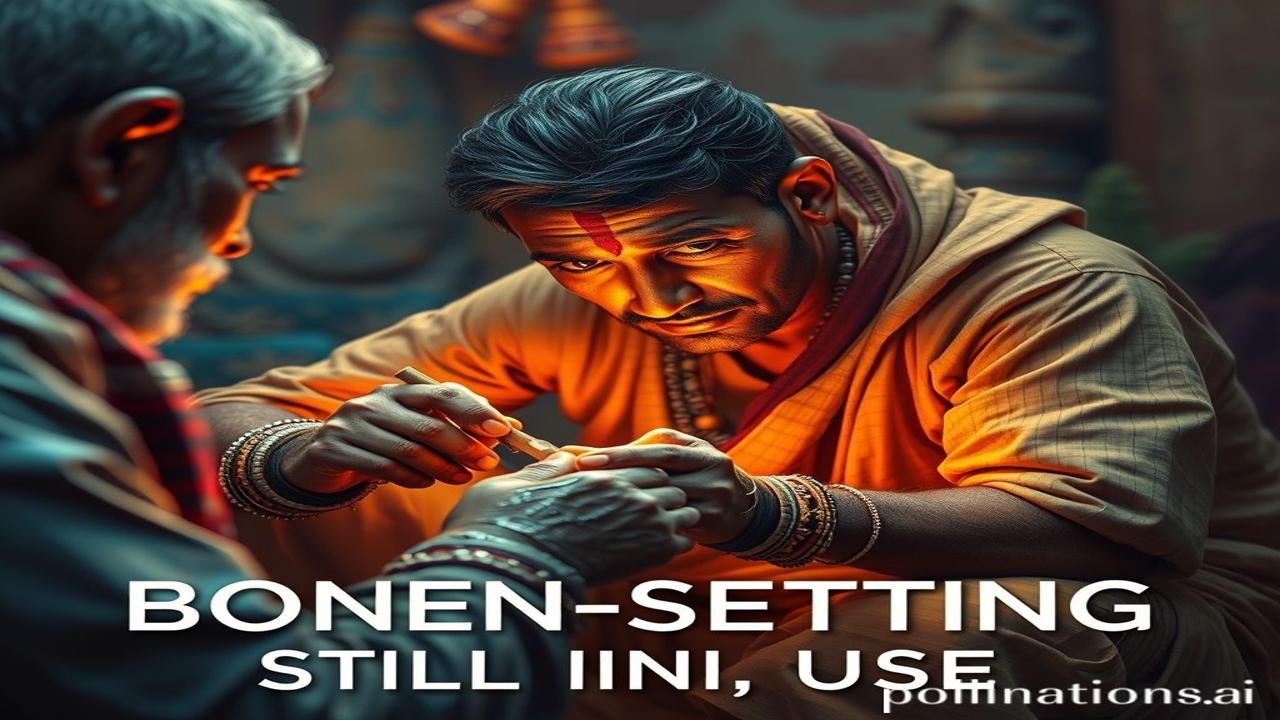“Had-vaid”: When Bones Whisper Ancient Secrets
Kabhi dekha hai kisi buzurg ko, jinki ungliyan haddiyon ke dard ko jaise samajhti hain? Kabhi socha hai, ki doctors aane se pehle, fractured bones ka ilaaj kaun karta tha? Waqt ki dhool mein aisi hi ek kahani chhupi hai – “Had-vaid” yaani traditional bone-setters ki.
This isn’t just a medical practice; it’s a living link to our ancestors, a testament to indigenous knowledge passed down through generations. Aaj bhi, in remote villages aur shehron ki chuppi galiyon mein, you can find these skilled healers who mend broken bones and soothe aching joints using age-old techniques.
A Legacy Etched in Time: The Historical Tapestry of Bone Setting
Traditional bone setting, or “Had-vaidi,” is an ancient practice deeply rooted in the Indian subcontinent. Iski roots ayurveda aur siddha jaisi paramparik chikitsa paddhatiyon mein milti hain. We’re talking about a history that stretches back thousands of years, predating modern medicine by millennia!
Imagine the era of emperors and empires. Warriors returning from battle with shattered limbs, artisans with injuries from their craft, and farmers facing accidents in the fields – who did they turn to? They turned to the local Had-vaid.
These weren’t just healers; they were integral parts of the community, possessing knowledge passed down through families, often guarded jealously and shared only with chosen apprentices. They used natural remedies – herbs, oils, and specific massage techniques – to align bones and facilitate healing. No x-rays, no fancy equipment – just skilled hands and an intimate understanding of the human anatomy.
Why is it important? Because it represents a self-reliant, resource-based healthcare system. It shows the ingenuity and resilience of our ancestors in tackling health challenges with what they had around them. It’s a vital part of our dharohar (heritage).
ज़मीनी सच – Life, Lore, and the Touch of Healing Hands
Picture this: It’s a scorching summer afternoon in a Rajasthani village. A young boy, Govind, falls from a tree, his arm twisted at an unnatural angle. His mother, distraught, rushes him to the village Had-vaid, Ramlal kaka.
Ramlal kaka, a man with wrinkled hands and knowing eyes, has been practicing Had-vaidi for over 40 years. He feels Govind’s arm, listens to the boy’s cries, and with gentle but firm movements, begins to manipulate the bone. He chants a mantra under his breath, a prayer for healing.
“Dar mat beta,” Ramlal kaka says softly, wiping Govind’s tears. “Dard hoga, par sab theek ho jayega.”
He applies a paste made from haldi (turmeric) and methi (fenugreek) to the injured area, then carefully splints the arm with bamboo sticks and cloth bandages.
Ramlal kaka knows that this isn’t just about setting bones; it’s about providing comfort, reassurance, and hope to the family. He understands the life of the village, the hard labor, the lack of resources, and the deep faith in traditional remedies. For him, Had-vaidi is not just a profession; it’s a calling, a seva (service) to his community.
This is the reality of Had-vaidi – a human connection, a reliance on nature, and a profound understanding of the body’s ability to heal.
धरोहर और पहचान – Cultural Resonance in Modern India
Despite the advancements in modern medicine, traditional bone-setting techniques still hold relevance in contemporary India.
Why? Because:
- Accessibility: In remote areas with limited access to hospitals and doctors, Had-vaids offer a readily available and affordable alternative.
- Cultural Beliefs: Many people prefer traditional methods due to a deep-rooted faith in the efficacy of natural remedies and ancestral knowledge.
- Holistic Approach: Had-vaids often combine bone setting with herbal medicine and massage, addressing not just the physical injury but also the overall well-being of the patient.
You might find elements of Had-vaidi integrated into certain Ayurvedic treatments and traditional healing centers. This practice is a thread in the rich tapestry of Bharatiyata, reminding us of our connection to nature, our reliance on indigenous knowledge, and the enduring power of human touch.
मजेदार तथ्य या भ्रम-भंजक – Myth Busting Time!
Myth: Had-vaids are untrained and unqualified quacks.
Truth: While there may be some unqualified practitioners, genuine Had-vaids possess years of experience and specialized knowledge passed down through generations. Their skills are honed through observation, apprenticeship, and practical application. They may lack formal medical degrees, but their understanding of bone structure, muscular anatomy, and herbal remedies is often profound.
दृश्य और भावनाएं – The Senses Awaken
Imagine walking into a Had-vaid’s clinic: The air smells of earthy herbs and healing oils. The walls are adorned with faded pictures of deities and dried medicinal plants. The sounds of gentle chanting mix with the creaks of wooden furniture. You feel a sense of calm and trust, a connection to a tradition that has healed generations. The touch of the Had-vaid’s hands is firm yet reassuring, instilling a belief in the body’s capacity to mend.
अंतिम विचार या उद्धरण – A Closing Reflection
The Had-vaids of India are keepers of ancient wisdom, reminding us that healing is not just about science, but also about compassion, connection, and faith.
As the great physician Sushruta said, “आयुर्वेदः शाश्वतो लोके” – “Ayurveda is eternal in the world.” And within Ayurveda, and within our culture, lies the tradition of the Had-vaid, whispering ancient secrets into the bones of those who seek healing.
“Haddiyon ki zubaan, sanskriti ka geet, yeh Bharat ki dharti, yeh healing ka meet.”
